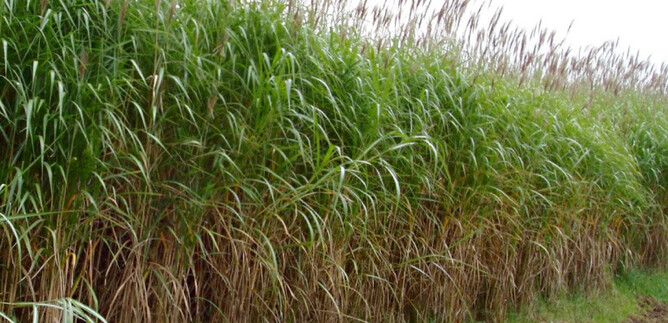In the United States, research began at the University of Illinois at Urbana-Champaign in 2001. Miscanthus Giganteus has been proposed for use in the United States in combined heat and power generation, as a supplement or on its own. It is also a leading candidate feedstock for cellulosic ethanol. Miscanthus Giganteus could meet biofuel goals without bringing new land into production or displacing food supply.
Miscanthus Giganteus is one of the most promising biomass crops in the United States today. It is a cold-tolerant cousin of sugarcane and capable of high biomass yields at cool temperatures. Further, it tolerates marginal lands and some flooding. It is more amenable to thermochemical conversion to biofuel than biochemical conversion, with good potential for the heat and power as well as animal bedding industries. Miscanthus Giganteus is distinguished from other biomass crops by its high yields, particularly at cool temperatures, which can be more than double those typical of switchgrass.
Miscanthus Giganteus shows an inconsistent response to fertilizer and is generally characterized by low input requirements for production. These low inputs and consistently high yields make Miscanthus Giganteus more profitable that corn/soy in the Midwest over the long term, despite the high cost of establishment given that the crop must be established vegetatively from rhizomes or plugs. Using high-yielding biomass crops like Miscanthus Giganteus for fuel over food crops like corn may allow the United States to achieve its biofuel mandates without competition between food and fuel.
Crop Sciences Professor Stephen P. Long says:
“What we’ve found with Miscanthus is that the amount of biomass generated each year would allow us to produce about 2 1/2 times the amount of ethanol we can produce per acre of corn. In trials across Illinois, switchgrass, a perennial grass which, like Miscanthus, requires fewer chemical and mechanical inputs than corn, produced only about as much ethanol feedstock per acre as corn.
One of the criticisms of using any biomass as a biofuel source is it has been claimed that plants are not very efficient – about 0.1 percent efficiency of conversion of sunlight into biomass. What we show here is on average Miscanthus is in fact about 1 percent efficient, so about 1 percent of sunlight ends up as biomass. Field trials also showed that Miscanthus is tolerant of poor soil quality.
The highest productivity is occurring in the south, on the poorest soils in the state, so that shows us that this type of crop may be very good for marginal land or land that is not even being used for crop production.
Because Miscanthus is a perennial grass, it also accumulates much more carbon in the soil than an annual crop such as corn or soybeans. In the context of global change, that’s important because it means that by producing a biofuel on that land you’re taking carbon out of the atmosphere and putting it into the soil.
Research has led to improvements in productivity and growers are poised to begin using it as a biofuels crop on a large scale.”
Quote Source: https://www.sciencedaily.com/releases/2008/07/080730155344.htm
Note: Content edited for style and length.


